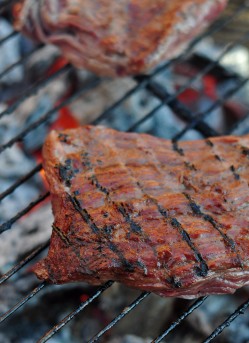When it comes to cooking pork on the grill, the optimal technique and temperature can vary wildly from one cut of meat to another. We have all bitten into a perfectly seared bone-in pork chop only to find a dry, leathery flip flop inside. While at times it can be frustrating for the beginner, pork is one of the most versatile and rewarding meats on the grill.
Basics of Pork on the Grill
Different pork cuts will require different cooking methods. For example, a tenderloin should be treated differently from a shoulder. Unfortunately, pork is not as forgiving as beef when it comes to moisture, so it is very important to know your meat and be prepared to grill it properly.
Remember that, in general, the meat you grill is muscle tissue. On a pig, different muscles are used in different ways. Some muscles, such as the shoulder, are used constantly as the pig moves about during its life. Other muscles, such as the tenderloin, are rarely used at all. The more a muscle is used, the more developed the muscle fibers become. Long and strong muscle fibers are naturally tough, but they also retain moisture. Less developed muscles are naturally tender, but they dry out easily because of their lack of collagen.
In general, the more developed a muscle is, the slower it needs to be cooked. A long slow cook allows the collagen in the muscle fibers to break down and lose cohesion. This is where we get pulled pork barbecue. A less worked muscle can be cooked hotter and faster, but extreme care ought to be given when it comes to temperature monitoring.
Flavors for Perfect Pork
Perhaps more than any other meat, pork pairs well with sweet flavors. Citrus, pineapple, blueberry, even maple flavors complement the natural sweetness of the meat. This is not to say that savory flavors do not work well with pork, but sweet flavors tend to have a more pleasing effect on guests.
Two Key Tips for Pork on the Grill
Temperature monitoring is important when grilling any meat, but it is especially important when dealing with pork chops, loin, and tenderloin. Purchase a good leave-in meat thermometer and use it to make sure you don’t overcook your meat. Take your meat off the grill when it is about 5 degrees shy of the target temperature. It will finish coming to temperature during the next most important stage of grilling: resting.
Resting your meat is nearly as important as not overcooking it. The rest allows the tight and strained meat fibers to relax and reabsorb juices. Without a rest, you will have dry meat in a pool of flavorful juice that would otherwise be in the meat.
Go back to BBQ Recipes Main Page
Go to iGrillBBQ.com Home Page from Pork on the Grill
